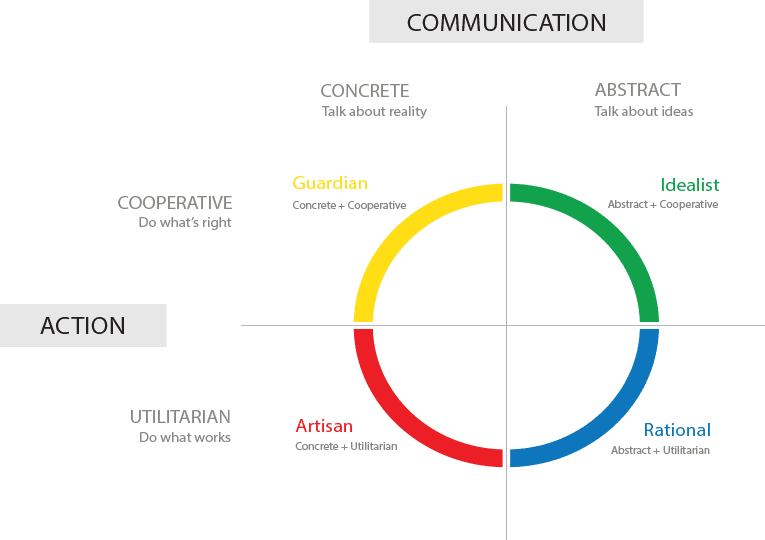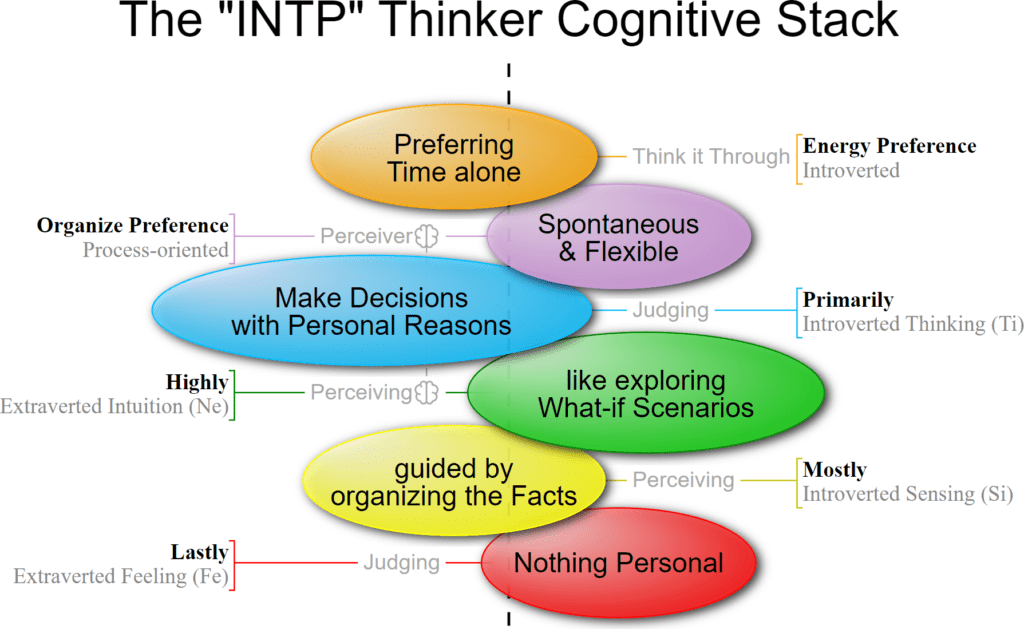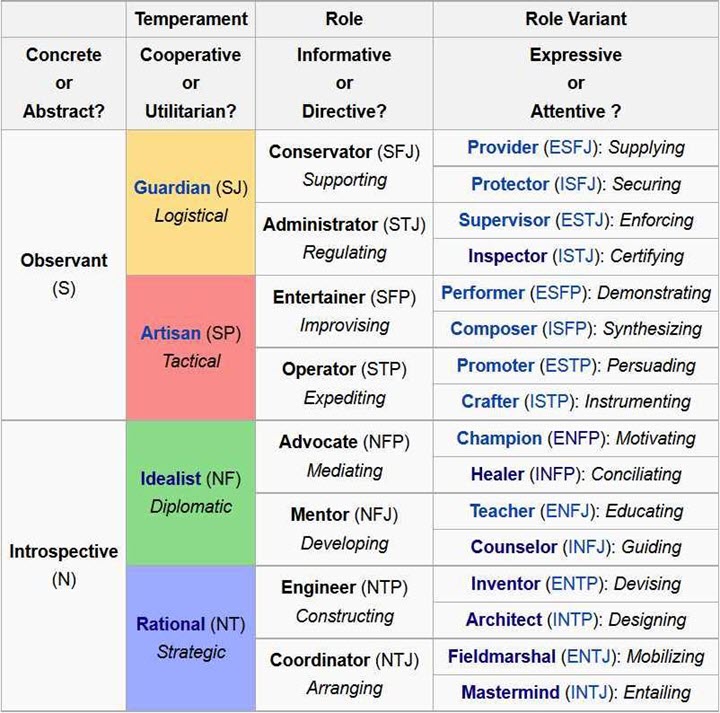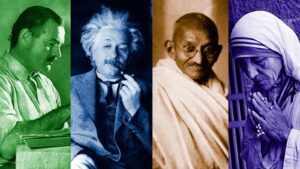What is the Keirsey INTP “Architect” Personality Type?
The Keirsey INTP “Architect” Personality Type is a Rational Temperament with an Abstract Communication Style and a Utilitarian Action Style.
Keirsey organized the Four Temperaments as a matrix. There are two communication styles, abstract and Concrete, similar to the Myers-Briggs Intuition (Abstract) and Sensing (Concrete) “Perceiving” Cognitive Functions.
And by two action styles: cooperative and utilitarian. Utilitarian people, for the most part, do what works, while Cooperative people do what’s right.
Keirsey named the Four Temperaments as suggested by Plato: Artisan (Iconic), Guardian (Pistic), Idealist (Noetic), and Rational (Dianoetic).

Concrete versus Abstract Communication Style
Keirsey divided the Four Temperaments into two Communication Styles: Abstract and Concrete. These styles resemble the Myers-Briggs Intuition and Sensing “Perceiving” Cognitive Functions.
Some people talk primarily about everyday reality’s external, concrete world: facts and figures, work and play, home and family, news, sports, and weather—all the who, what, when, where, and how of life.
Other people talk primarily about the internal, abstract world of ideas: theories and conjectures, dreams and philosophies, beliefs and fantasies—all the whys, ifs, and what might be of life.
Concrete people talk about reality in their daily lives, while Abstract people talk about ideas.
According to Keirsey, everyone can engage in both observation and introspection. People are observant when they touch objects or otherwise perceive the world through their five senses. When people reflect and focus on their internal world, they are introspective. However, individuals cannot engage in observation and introspection at the same time. The extent to which people are more observant or reflective affects their behavior.
People who are generally observant are more ‘down to earth.’ They are more concrete in their worldview and focus on practical matters such as food, shelter, and their immediate relationships. Carl Jung used the word sensation when describing people who prefer concrete perception.
Generally, reflective people have more ‘heads in the clouds’ and abstract worldviews. They focus on global or theoretical issues such as equality or engineering. Carl Jung used the word intuition to describe people who prefer abstract perception.
Cooperative versus Utilitarian Action Style
Some people act primarily practically or pragmatically; that is, they do what gets results, what achieves their objectives as effectively or efficiently as possible. They only check afterward to see if they observe the rules or go through the proper channels.
Other people act primarily cooperatively or socially acceptable; they try to do the right thing in keeping with agreed-upon social rules, conventions, and codes of conduct. Only later do they concern themselves with the effectiveness of their actions.
These two ways of acting can overlap, but as they lead their lives, Utilitarian people mostly do what works, while Cooperative people do what’s right.
Keirsey compares the differing temperaments with cooperative (Complying) and pragmatic (Adaptive) temperaments. Cooperative people pay more attention to other people’s opinions and are more concerned with doing the right thing. Sensible people (Utilitarian) pay more attention to their thoughts or feelings and are more concerned with doing what works. No comparable idea in the MBTI or Jung corresponds to this dichotomy, which is a significant difference between Keirsey’s work and Myers and Jung’s.
The pragmatic temperaments are Rational (pragmatic and abstract) and artisan (Pragmatic and concrete). The Cooperative Temperaments are Idealists (Cooperative and Abstract) and Guardians (Cooperative and Concrete). Neither the MBTI nor Jung included the concept of Temperament in their work.
INTP Keirsey/MBTI Correlation
| Keirsey | MBTI | |
|---|---|---|
| I | Attentive Role Variant | Introverted Thinking |
| N | Abstract Communication Style | Extraverted iNtuition Auxiliary Function |
| T | Utilitarian Action Style | Introverted Thinking Dominate Function |
| P | Informative Role | Intuition is a Perceiving Function |
With Introverted Thinker as the first Dominant Function and Extraverted Intuition as the second Auxiliary Function, the MBTI INTP “Thinker” Personality Type sorts to the Keirsey INTP “Architect” Personality Type.

INTP Personality Type cross-reference
- Keirsey Type – Architect
- Temperament Type – Choleric
- Animal Type – Lion
- DISC Type – Dominant
- Socio-Communicative Type – Driver
- True Colors – Green
- Color Code – Red
- Personality Compass – North
- Occupational Type – Enterprising
- Learning Type – Activist
- Leadership Type – Dominator
Enneagram Types
Architect Personality Characteristics
Architects need not be considered only interested in drawing blueprints for buildings, roads, or bridges. They are the master designers of all theoretical systems, including school curricula, corporate strategies, and new technologies. For Architects, the world exists primarily to be analyzed, understood, explained, and redesigned.
Architects must grasp fundamental principles and natural laws and create elegant, efficient, and coherent designs.
Architects are rare – maybe one percent of the population – and show incredible precision in thought and speech.
It is difficult for an Architect to listen to nonsense, even in a casual conversation, without pointing out the speaker’s error. Architects are devastating in any serious discussion or debate, and their skill in framing arguments gives them an enormous advantage.
Architects regard all discussions as a search for understanding and believe their function is to eliminate inconsistencies, which can make communication with them an uncomfortable experience for many.
Architects are driven to find the most efficient means to their ends and will learn in any manner and degree they can.
They will listen to amateurs if their ideas are helpful and ignore the experts if theirs are not. Authority derived from office, credentials, or celebrity does not impress them.
Architects are interested only in what makes sense; thus, only consistent and coherent statements carry any weight.
Architects often seem difficult to know.
They are inclined to be shy except with close friends, and their reserve is difficult to penetrate. Able to concentrate better than any other type, they prefer to work quietly at their computers or drafting tables, often alone.
Architects also become obsessed with analysis, which can seem to shut others out. Once caught up in a thought process, architects close off and persevere until they comprehend the issue and all its complexity.
Architects prize intelligence and can seem arrogant with their grand desire to grasp the universe’s structure. They may show impatience with others who are less capable or driven.
Famous Architects
Dr. David Keirsey, Robert Rosen, George Soros, Gregory Peck, James Madison, Ludwig Boltzmann, Charles Darwin, Adam Smith, Thomas Jefferson, and Albert Einstein, as the iconic Rational, are examples of the Architects’ Rationals.

What are the Keirsy Personality Temerpaments?

David Keirsey, born in 1921, was an American psychologist specializing in conflict management and family counseling. He began researching human behavior and Personality in the 1940s.
Keirsey blended the Myers-Briggs Personality Types with Ernst Kretschmer’s model of the Four Temperaments, developing the Keirsey Temperament Sorter, which was made famous by his book “Please Understand Me.”
Instead of using the term Personality, Keirsey used Temperament. He viewed it as a configuration of observable Personality Traits, communication habits, patterns of action, characteristic attitudes, values, and talents. To Keirsy, Temperament encompasses personal needs, individual contributions, workplace contributions, and societal roles.
Keirsey correlated the sixteen MBTI Personality Types into Four Temperaments. He divided each Temperament into two Roles: informative and Directive. He subdivided the roles into expressive (extraverted) and attentive (introverted) role Variables.
Informative versus Directive Roles
Keirsey distinguishes between people who generally communicate by informing others versus those who speak by directing others. This distinction subdivides each of the four Temperaments into eight Roles.
Expressive versus Attentive Role Variants
Individuals who act before observing are Expressive. In contrast, people who follow before working are Attentive.
Expressive and attentive variants further subdivide the eight roles into 16 types correlating to the 16 Myers-Briggs personality types.


